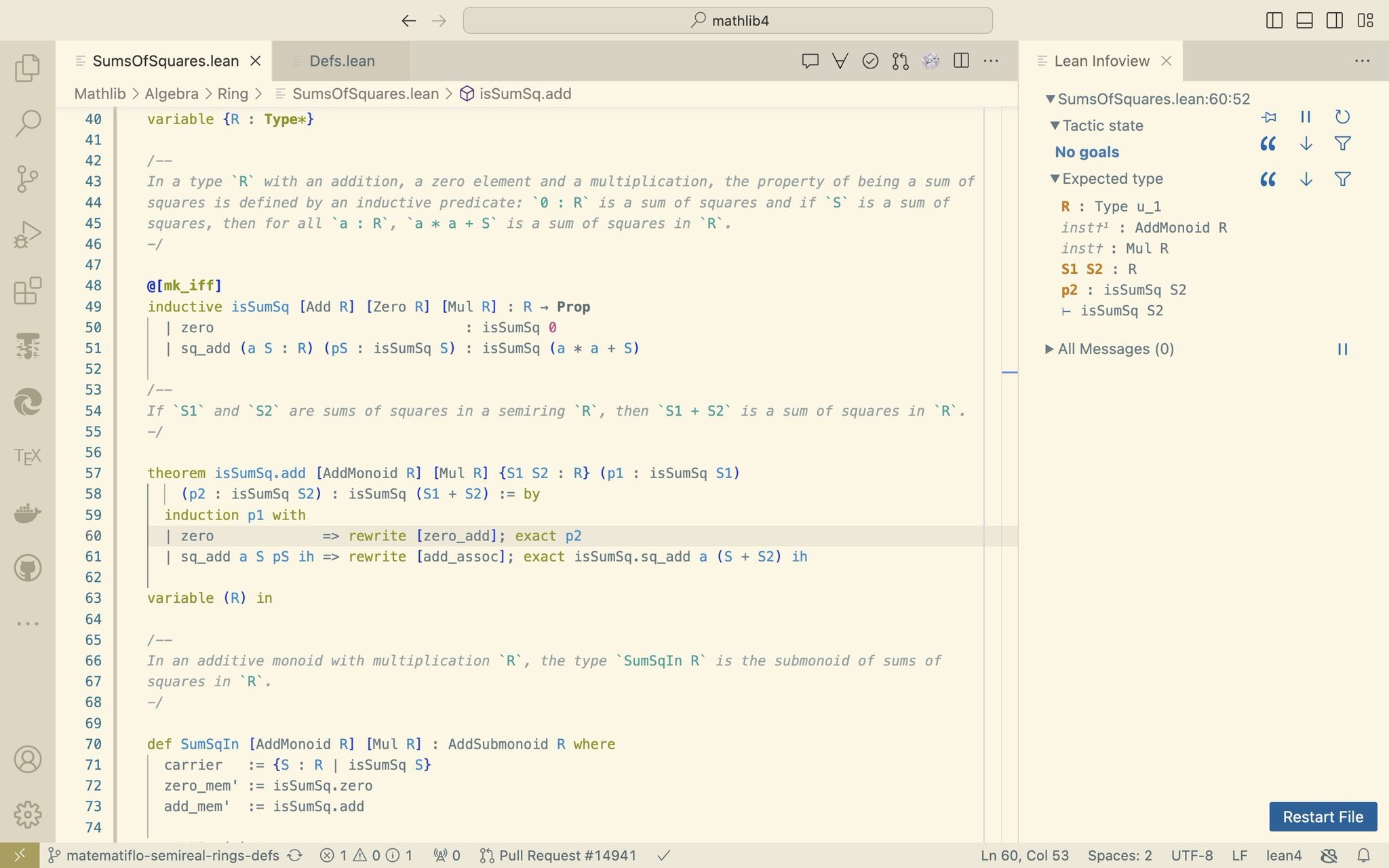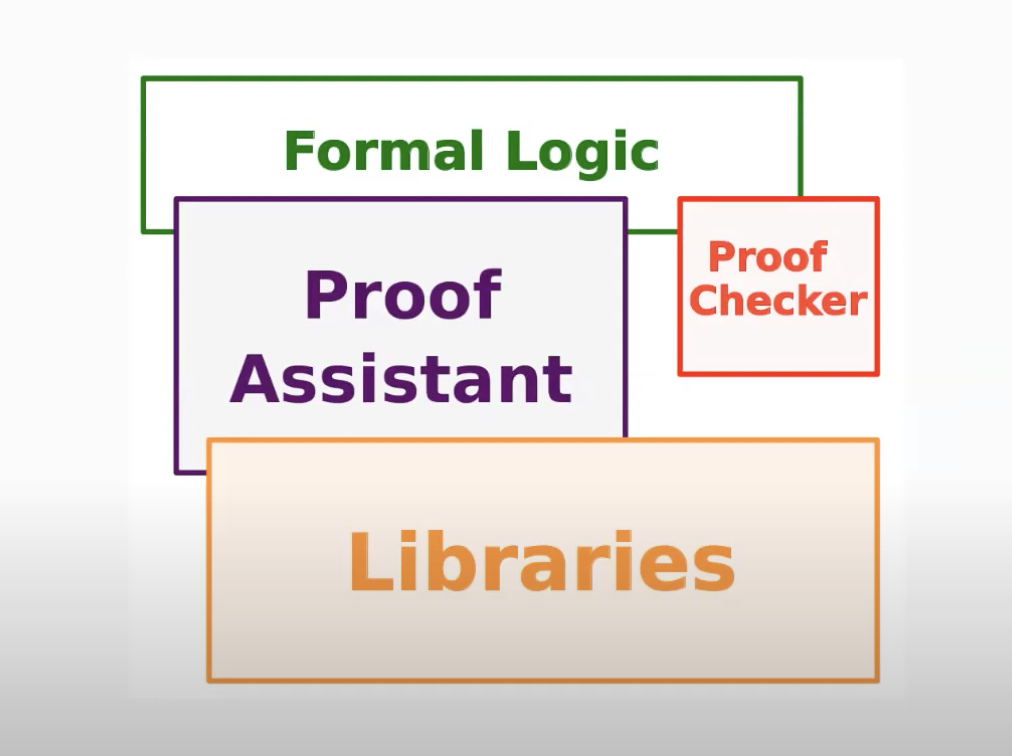Using Lean online
- You can use Lean via the Lean 4 Web server.
- Here is a practice file on basic Lean syntax:
Basic Lean syntax.
- The server enables you to load and save single Lean files (not suitable for multiple files projects). It provides access to Mathlib (Lean's main mathematical library).
Using Lean in an IDE
- Alternatively, one can install Lean locally and open Lean files in a code editor.
- VS Code and the Lean 4 extension are a popular choice among Lean users:

Installing Lean
- It is possible to install Lean directly from within VS Code, using the Lean 4 extension (install git first if you do not have it on your machine).
- For a more controlled installation, first install elan (the Lean version manager), then install Lean by running
elan install stable. To start a project, follow the instructions of the official Lean manual. - You can find all of this and more detailed installation instructions on the webpage of the Leanprover Community:
Online resources to get started
- The official Lean webpage.
- The Leanprover community website.
- The Lean Zulip channel.
The Lean game server
- The Lean game server is hosted at the Heinrich Heine Universität in Düsseldorf.
- The first Lean game was the Natural Number Game, created by Kevin Buzzard, Mohammad Pedramfar (original Lean 3 version) and Jon Eugster.
- It provides an introduction to the Lean language via a construction of the main properties of the natural numbers.
Natural Number Game.
Lean's ecosystem
- Libraries.
- Collaborative projects.
- Documentation, search engines and more.
Available Lean libraries
There is a standard library shipped with Lean. The file Init.Prelude is imported by default when you open a Lean file.
Other libraries can be used as dependencies in a Lean package:
- Mathlib: a user-maintained mathematical library (research-level).
- Batteries: an extended standard library, for use in both computer science and mathematics.
- SciLean: scientific computing in Lean 4.
Lean and all the libraries above are open-source (under an Apache 2.0 license).
The code is freely accessible on GitHub.
Mathlib
- Mathlib is a community-driven effort to build a unified library of mathematics formalized in the Lean proof assistant
- As of October 2024: ~350 contributors, 1.5 million lines of code.
- Mathlib already contains a lot of university and research-level mathematics. It is an academic project, to which anyone can submit a contribution.
- It is already being used in major online collaborative research projects, some of them involving Fields medallists Peter Scholze and Terence Tao.
Online Collaborative Projects
- The goal of such a project is to formalize a piece of mathematics. There are at least two aspects to this:
- Finding a way to represent mathematical objects in a programming language.
- Using the typing constraints of that programming language to check the syntactical correctness of a mathematical statement.
- Various formalization projects in Lean focus on the verification of mathematical proofs, in a variety of research fields:
- The Liquid Tensor Experiment (condensed mathematics).
- The Prime Number Theorem.
- The sphere eversion theorem.
- The generalized Carleson's theorem.
Collaboration tools
- A formalization project can involve tens of different people. Once the project is broken into subgoals, it is possible for people from distinct areas of research or with different levels of experience to work together.
- Discussion happens online, in the Lean Zulip channel, and the code repository is hosted on GitHub or a similar service.
- Recent efforts include developing the automation of certain tasks, sometimes using large language models (AI).
Blueprints
- A Lean blueprint establishes an interface between a mathematical text in the classical sense, written in
- It generates a dependency graph, showing the advancement of the formalization process (not formalized, statement formalized, proof formalized).
- The blueprint gets updated as the Lean code is being written.
The Blueprint for Fermat’s Last Theorem
Kevin Buzzard is currently leading the formalization of Fermat's Last Theorem (2024-2029). The big picture for the proof can be visualized as follows thanks to Lean blueprint:

The colour code shows the advancement of the project towards completion.
Documentation
The following tools are indispensable when writing Lean code:
- The Mathlib documentation. It also includes Lean's core library and Batteries. The search is conducted by name (identifier).
- Loogle: the official Lean language search engine. There it is possible to search for a given type signature, such as
(?a -> ?b) -> List ?a -> List ?b. - Moogle and LeanSearch: AI-powered search engines. There you can use natural language, such as
order subgroup divides order groupordim V = dim (Ker u) + dim (Im u).
References to get you started
The following web-based books are standard references in the Leanprover community:
- The Hitch-hiker's guide to Logical verification (2025 edition), by Anne Baanen, Alexander Bentkamp, Jasmine Blanchette, Xavier Généreux, Johannes Hölzl, and Jannis Limperg.
- Theorem Proving in Lean 4, by Jeremy Avigad, Leonardo de Moura, Soonho Kong and Sebastian Ullrich (based on the 2017 Lean 3 version).
- Mathematics in Lean, by Jeremy Avigad and Patrick Massot (2020).
- Mechanics of proof, by Heather MacBeth (2022-2024).
- Functional Programming in Lean, by David Thrane Christensen (2023).
Lake and Reservoir
- Lean's build tool and package manager is called Lake (lean make).
- To start a Lean project, you can use
lake initorlake new(trylake --helpfirst). This can also be done directly from within VS Code, using the Lean 4 extension. - Lean's packages can be hosted on Reservoir, Lean's package registry.
Basic Lean syntax
- Terms and types.
- Curried functions.
- Inductive types.
What is a type?
Depending on whom you ask, a type may be seen as:
- An annotation to a term, controlling the operations that are permitted on that term:
(3 : Nat),(-4 : Int),([1, 2, 3] : List Nat),(Nat.mul : Nat → Nat → Nat). - A list of common rules to introduce and eliminate certain terms.
- A good substitute for the notion of topological space.
Every term has an associated type, which is part of its definition as a term. Since they do not have the same type, (3 : Nat) and (3 : Int) are different objects. Expressions such as x := x + 1 are not well-typed and do not make sense in a functional programming language.
Well-typed expressions
In Lean, you can find out the type of an expression by using the #check command:
#check 42 -- 42 : Nat
#check Nat -- Nat : Type
#check Nat.mul -- Nat.mul : Nat → Nat → Nat
#check "42" -- "42" : String
#check 1 + 1 -- 1 + 1 : Nat
#check 1 + 1 = 2 -- 1 + 1 = 2 : Prop
#check 1 + 1 > 2 -- 1 + 1 > 2 : Prop
Note that a well-typed expression can be recognised as a proposition regardless of whether it is "mathematically correct". The expression 2 + 2 = 5, for instance, is well-typed / syntactically correct (an equality between two natural numbers). In contrast, a common expression such as 2 * (3 + 1) = 2 * 3 + 2 * 1 = 8 is not well-typed.
Why bother?
It is common sense not to mix quantities that are not related to one another. Here is an example of an ill-typed expression.
 Image credits: MikeGogulski, CC BY-SA 3.0.
Image credits: MikeGogulski, CC BY-SA 3.0.
Some milestones in the development of type theory
- 1912: Bertrand Russell introduces types, hoping to avoid the emergence of paradoxes.
- 1940: Alonzo Church develops a simply-typed version of his
- 1967: De Bruijn introduces the Automath programming language, in which he effectively equates proof and type inhabitation.
- 1973: Per Martin-Löf proposes a dependent type theory that can be used as an alternative foundations system for mathematics. This is the underlying logic of Lean.
- 1989: Thierry Coquand releases the first official version of Coq (now known as Rocq), a type-checker that supports all the constructs of Martin-Löf type theory.
- 2013: Vladimir Voevodsky and his collaborators publish a treatise on Homotopy Type Theory, which is the basis for the univalent foundations of mathematics.
Structure of an interactive theorem prover
The architecture of an interactive theorem prover can be represented as follows.
 Image credits: Assia Mahboubi.
Image credits: Assia Mahboubi.
- Human users interact with the proof assistant by writing libraries.
- The compiler checks that the code is syntactically correct.
- Type theory is a convenient choice of underlying logic for functional programming.
Mathematical functions
- Simply-typed functions
f : X → Yare the basic objects of a language like Lean. - Their implementation can look similar to the usual mathematical definition:
def fact : Nat → Nat
| 0 => 1
| k + 1 => (k + 1) * fact k
#check fact -- fact : Nat → Nat
#check fact 5 -- fact 5 : Nat
#eval fact 5 -- 120
Curried functions
- The natural way to define a function of two variables in Lean is to use curried notation.
- A function of two variables
- In functional programming languages, when we write
f : A → B → C, then, in the expressionf a b, the termf ais a function fromBtoC, and it is applied tob.
def sum : Nat → Nat → Nat := fun x y ↦ x + y
#check sum 3 -- sum 3 : Nat → Nat
#eval sum 3 5 -- 8
If we set instead def sum₁ : Nat → Nat → Nat := fun x ↦ (fun y ↦ x + y), then we get sum = sum₁, by reflexivity.
Higher-order functions
- We can write curried functions with an arbitrary number of variables: if
f : A → B → C → D → E, then for alla : A,b : B,c : C,d : D, we havef a b c d : E. - This is not the same as
f : A → (B → C) → D → E, which takes as arguments a terma : A, a functionu : B → Cand a termd : D, returning a term of typeE. A → B → C → D → Eis the same asA → (B → (C → (D → E))).
def f : Nat → (Nat → ℝ) → ℝ → ℝ :=
fun (n : Nat) (u : Nat → ℝ) (x : ℝ) ↦ 2 ^ n * u n + x
def v : Nat → ℝ := fun n ↦ 2 * n
#eval f 3 v (-6) -- 42
Inductive types
The most famous inductive type in mathematics is probably the type Nat, whose definition goes back to Giuseppe Peano in 1889. In Lean, it is implemented as follows.
inductive Nat : Type
| zero : Nat
| succ : Nat → Nat
Inductive definitions produce special functions called constructors. In the present case, there are two of them (two introduction rules for terms of type Nat):
Nat.zero : Nat(a function whose value is its own name is called an atom, you can view it as a function from theUnittype toNat, if you prefer).Nat.succ : Nat → Nat(the successor function), saying that for everyn : Natthere is a termn.succ : Nat(dot notation forNat.succ (n : Nat)).
Product types are inductive types
The fact that product types are defined inductively may seem less familiar to mathematicians.
inductive Prod (X Y : Type) : Type
| mk : X → Y → Prod X Y
This means that terms of type Prod X Y are introduced via the constructor Prod.mk : X → Y → Prod X Y. In other words, for all x : X and all y : Y, the term Prod.mk x y is of type Prod X Y and this is the only introduction rule for terms of type Prod X Y. In Lean, the type Prod X Y can be denoted by X × Y and its terms by ⟨x, y⟩ (angle brackets).
Functions out of an inductive type
- We have already seen examples of a function
f : Nat → Nat, namely the factorial function. It was defined by induction. Since the constructorNat.succis a function fromNattoNat, the induction principle forNatincludes a recursive call: to definef (n + 1), we may usenandf n, as in the definition offact (n + 1). - However, induction is not limited to
Nat: every inductive type has an associated induction principle. For the product, it implies in particular that, in order to define a functionf : X × Y → Z, it suffices to define it on the canonical termsProd.mk x y. In practice, this is done via pattern matching.
def proj₁ {X Y : Type} : X × Y → X
| Prod.mk x y => x
The sum of two types
- The sum
- The inductive type
- To eliminate terms of type
inductive Sum (X Y : Type) : Type
| inl : X → Sum X Y
| inr : Y → Sum X Y
def characteristic_function_of_second_summand {X Y : Type} : X ⊕ Y → Bool
| Sum.inl x => (false : Bool)
| Sum.inr y => (true : Bool)
Wrap-up and where to go from here
- Statically-typed functional programming languages with type inference capabilities such as Lean 4 can be used to formalise mathematics.
- Type-checking means verifying that our code is syntactically correct.
- Curried functions and inductive types are used in a variety of contexts and for many purposes, in particular to formalise mathematics.
- To each inductive type there is associated an induction principle. In practice, we can define functions out of an inductive type by pattern matching on the constructors of an inductive type.
- Now let us write some Lean code
!
Practice file on Lean syntax
Piece of trivia: often seen in Lean examples,


